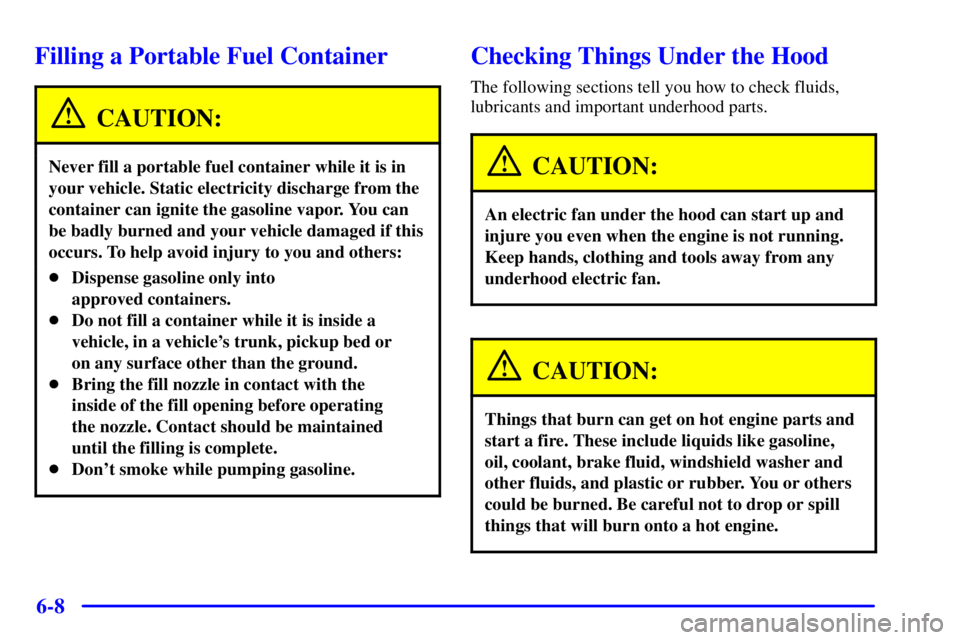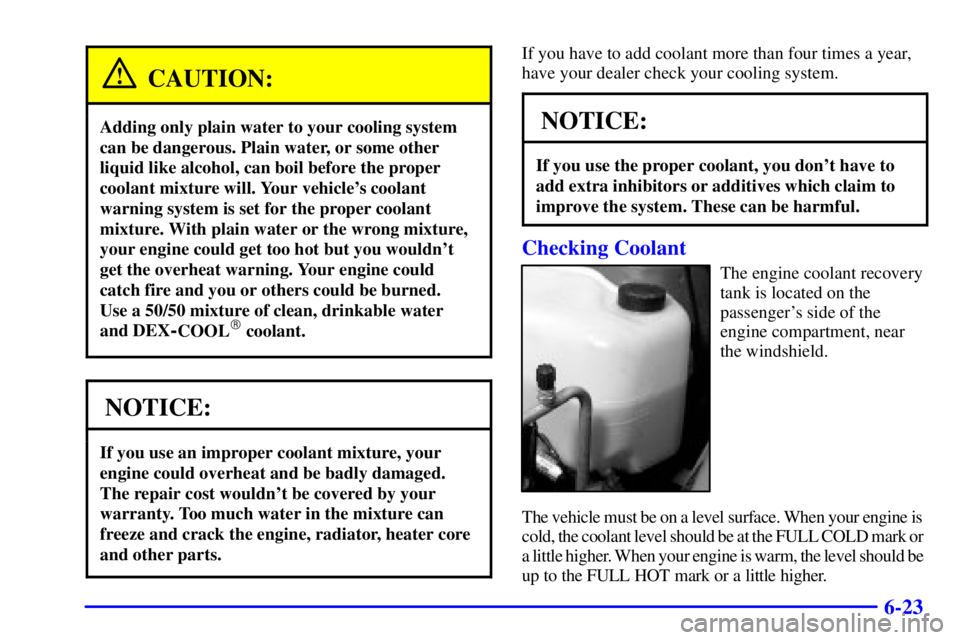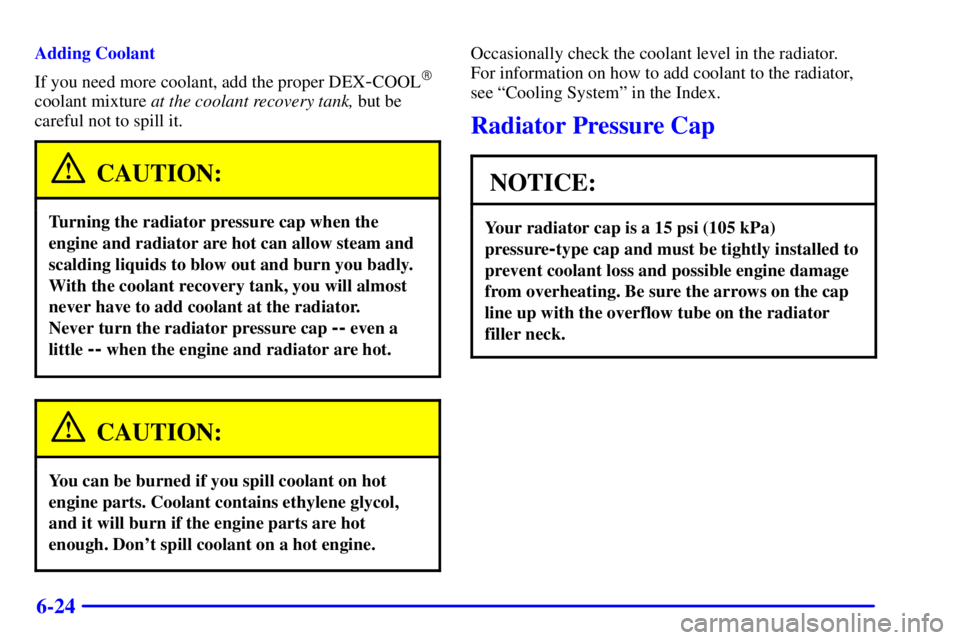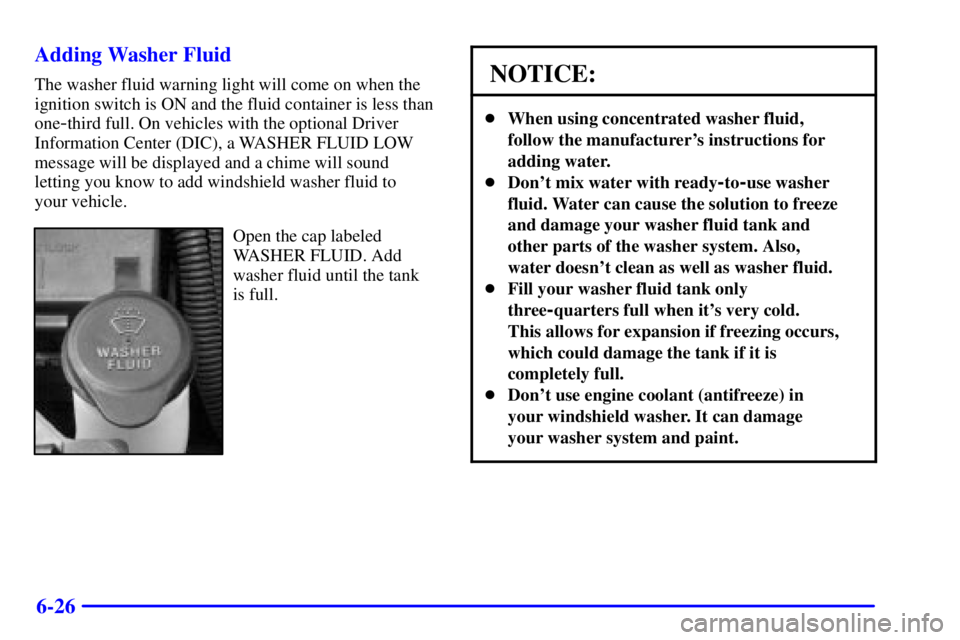Page 283 of 402

6-8
Filling a Portable Fuel Container
CAUTION:
Never fill a portable fuel container while it is in
your vehicle. Static electricity discharge from the
container can ignite the gasoline vapor. You can
be badly burned and your vehicle damaged if this
occurs. To help avoid injury to you and others:
�Dispense gasoline only into
approved containers.
�Do not fill a container while it is inside a
vehicle, in a vehicle's trunk, pickup bed or
on any surface other than the ground.
�Bring the fill nozzle in contact with the
inside of the fill opening before operating
the nozzle. Contact should be maintained
until the filling is complete.
�Don't smoke while pumping gasoline.
Checking Things Under the Hood
The following sections tell you how to check fluids,
lubricants and important underhood parts.
CAUTION:
An electric fan under the hood can start up and
injure you even when the engine is not running.
Keep hands, clothing and tools away from any
underhood electric fan.
CAUTION:
Things that burn can get on hot engine parts and
start a fire. These include liquids like gasoline,
oil, coolant, brake fluid, windshield washer and
other fluids, and plastic or rubber. You or others
could be burned. Be careful not to drop or spill
things that will burn onto a hot engine.
Page 285 of 402
6-10 3800 V6 Series II Engine (L36)
When you open the hood on the 3800 (L36) engine, here's what you will see (3800 Supercharged (L67) engine similar):
A. Engine Coolant Recovery Tank
B. Power Steering Fluid
C. Automatic Transaxle Fluid Dipstick
D. Brake Master Cylinder
E. Windshield Washer Fluid ReservoirF. Radiator Pressure Cap
G. Engine Oil Dipstick
H. Engine Oil Fill Cap
I. Engine Air Cleaner/Filter
Page 297 of 402

6-22
Engine Coolant
The cooling system in your vehicle is filled with
DEX
-COOL� engine coolant. This coolant is designed
to remain in your vehicle for 5 years or 150,000 miles
(240 000 km), whichever occurs first, if you add only
DEX
-COOL� extended life coolant.
The following explains your cooling system and how to
add coolant when it is low. If you have a problem with
engine overheating, see ªEngine Overheatingº in
the Index.
A 50/50 mixture of clean, drinkable water and
DEX
-COOL� coolant will:
�Give freezing protection down to
-34�F (-37�C).
�Give boiling protection up to 265�F (129�C).
�Protect against rust and corrosion.
�Help keep the proper engine temperature.
�Let the warning lights and gages work as
they should.
NOTICE:
When adding coolant, it is important that you use
only DEX
-COOL� (silicate-free) coolant.
If coolant other than DEX-COOL is added to the
system, premature engine, heater core or
radiator corrosion may result. In addition, the
engine coolant will require change sooner
-- at
30,000 miles (50 000 km) or 24 months,
whichever occurs first. Damage caused by the use
of coolant other than DEX
-COOL� is not
covered by your new vehicle warranty.
What to Use
Use a mixture of one-half clean, drinkable water and
one
-half DEX-COOL� coolant which won't damage
aluminum parts. If you use this coolant mixture, you
don't need to add anything else.
Page 298 of 402

6-23
CAUTION:
Adding only plain water to your cooling system
can be dangerous. Plain water, or some other
liquid like alcohol, can boil before the proper
coolant mixture will. Your vehicle's coolant
warning system is set for the proper coolant
mixture. With plain water or the wrong mixture,
your engine could get too hot but you wouldn't
get the overheat warning. Your engine could
catch fire and you or others could be burned.
Use a 50/50 mixture of clean, drinkable water
and DEX
-COOL� coolant.
NOTICE:
If you use an improper coolant mixture, your
engine could overheat and be badly damaged.
The repair cost wouldn't be covered by your
warranty. Too much water in the mixture can
freeze and crack the engine, radiator, heater core
and other parts.
If you have to add coolant more than four times a year,
have your dealer check your cooling system.
NOTICE:
If you use the proper coolant, you don't have to
add extra inhibitors or additives which claim to
improve the system. These can be harmful.
Checking Coolant
The engine coolant recovery
tank is located on the
passenger's side of the
engine compartment, near
the windshield.
The vehicle must be on a level surface. When your engine is
cold, the coolant level should be at the FULL COLD mark or
a little higher. When your engine is warm, the level should be
up to the FULL HOT mark or a little higher.
Page 299 of 402

6-24
Adding Coolant
If you need more coolant, add the proper DEX
-COOL�
coolant mixture at the coolant recovery tank, but be
careful not to spill it.
CAUTION:
Turning the radiator pressure cap when the
engine and radiator are hot can allow steam and
scalding liquids to blow out and burn you badly.
With the coolant recovery tank, you will almost
never have to add coolant at the radiator.
Never turn the radiator pressure cap
-- even a
little
-- when the engine and radiator are hot.
CAUTION:
You can be burned if you spill coolant on hot
engine parts. Coolant contains ethylene glycol,
and it will burn if the engine parts are hot
enough. Don't spill coolant on a hot engine.
Occasionally check the coolant level in the radiator.
For information on how to add coolant to the radiator,
see ªCooling Systemº in the Index.
Radiator Pressure Cap
NOTICE:
Your radiator cap is a 15 psi (105 kPa)
pressure
-type cap and must be tightly installed to
prevent coolant loss and possible engine damage
from overheating. Be sure the arrows on the cap
line up with the overflow tube on the radiator
filler neck.
Page 301 of 402

6-26 Adding Washer Fluid
The washer fluid warning light will come on when the
ignition switch is ON and the fluid container is less than
one
-third full. On vehicles with the optional Driver
Information Center (DIC), a WASHER FLUID LOW
message will be displayed and a chime will sound
letting you know to add windshield washer fluid to
your vehicle.
Open the cap labeled
WASHER FLUID. Add
washer fluid until the tank
is full.
NOTICE:
�When using concentrated washer fluid,
follow the manufacturer's instructions for
adding water.
�Don't mix water with ready
-to-use washer
fluid. Water can cause the solution to freeze
and damage your washer fluid tank and
other parts of the washer system. Also,
water doesn't clean as well as washer fluid.
�Fill your washer fluid tank only
three
-quarters full when it's very cold.
This allows for expansion if freezing occurs,
which could damage the tank if it is
completely full.
�Don't use engine coolant (antifreeze) in
your windshield washer. It can damage
your washer system and paint.
Page 346 of 402
6-71 Vehicle Dimensions
Wheelbase 112.2 inches (285.0 cm). . . . . . . . . . . . . .
Tread Width
Front 62.4 inches (158.5 cm). . . . . . . . . . . . . . . . . .
Rear 62.3 inches (158.2 cm). . . . . . . . . . . . . . . . . . .
Length 202.6 inches (514.6 cm). . . . . . . . . . . . . . . . .
Width 73.8 inches (187.5 cm). . . . . . . . . . . . . . . . . . .
Height 56.0 inches (142.2 cm). . . . . . . . . . . . . . . . . . .
L36 Engine Accessory Belt
The 3800 V6 (L36) engine uses an engine accessory
belt. This diagram shows the features connected and the
routing. See ªMaintenance Scheduleº in the Index for
when to check the belt.
A. Power Steering
B. Generator
C. Air ConditioningD. Crank
E. Coolant Pump
F. Idler
Page 347 of 402
6-72 L67 Engine Accessory Belt
The Supercharged 3800 V6 (L67) engine uses two
accessory drive belts. The inner belt drives the
generator, power steering pump, coolant pump and air
conditioning. The outer belt drives the supercharger.
Each belt has its own tensioner and idler pulley. See
ªMaintenance Scheduleº in the Index for when to check
the accessory drive belts and the supercharger oil level.
Have your dealer check the oil level in the supercharger.
1. Front Belt
2. Back Belt
A. Generator
B. Power Steering PumpC. Crank
D. Supercharger
E. Coolant Pump
F. Air Conditioning